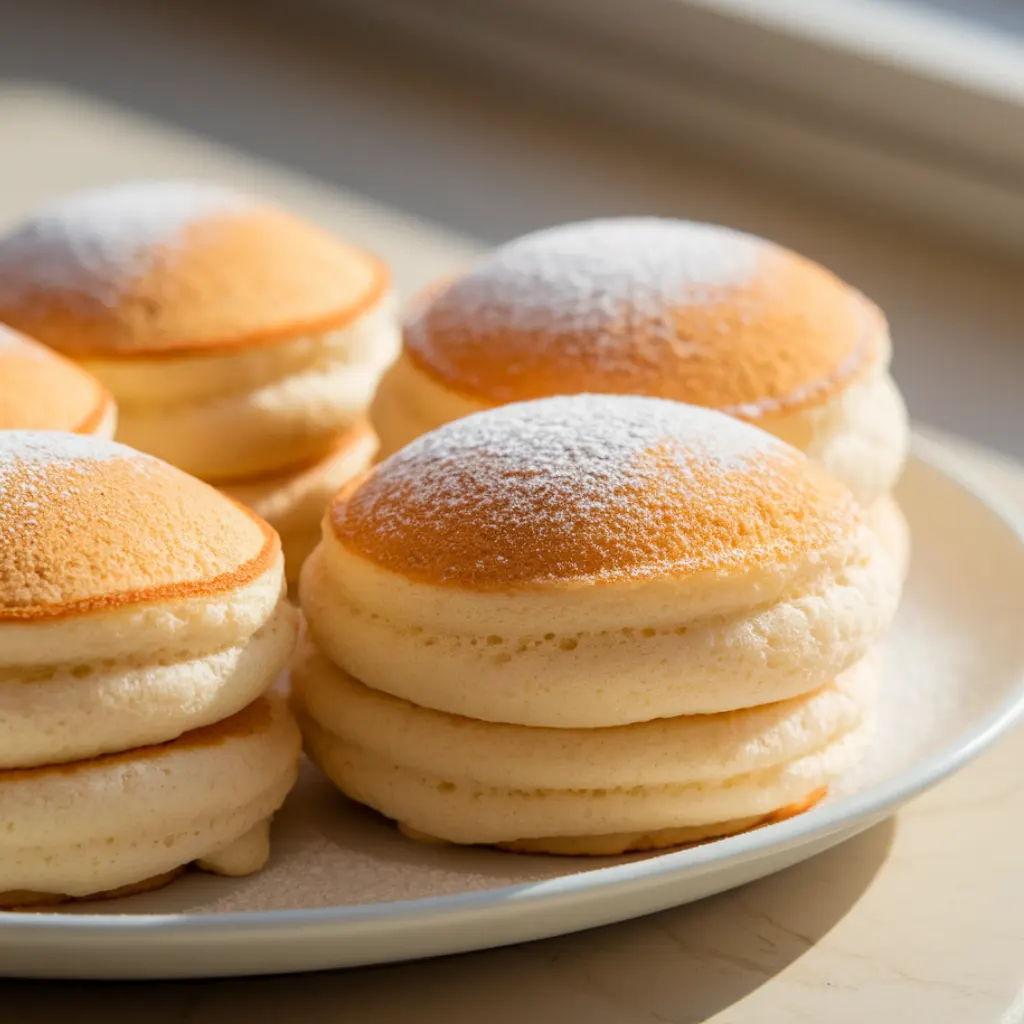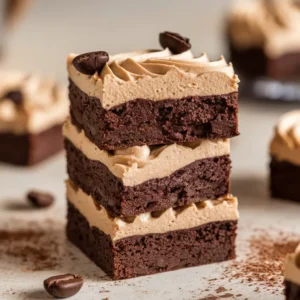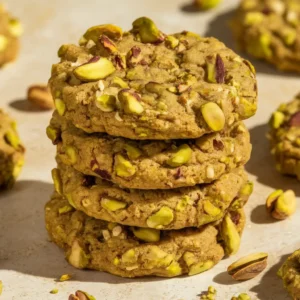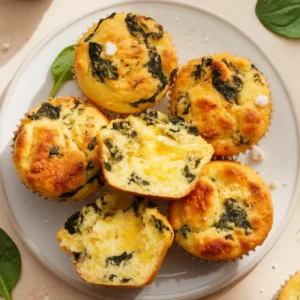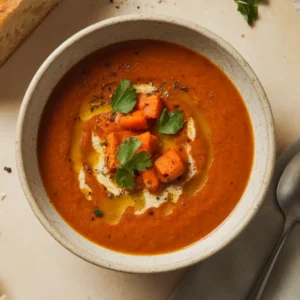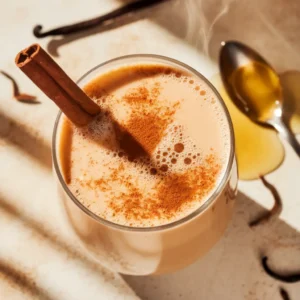Japanese souffle pancakes are one of those things you see on Instagram and immediately think, “No way I’m making that at home.” They’re tall, wobbly, impossibly fluffy, and seem like they belong exclusively in trendy Tokyo cafes. But here’s the thing—once you understand what makes them work, they’re completely doable in a regular kitchen with tools you already own.
The secret isn’t magic or years of culinary training lol (Just kidding :)). It’s about whipping egg whites properly, folding gently, and having the patience to cook them low and slow. That’s it. This recipe breaks down each step so you know exactly what to look for, what can go wrong, and how to fix it. Whether you’re making these for a birthday breakfast, a lazy Sunday brunch, or just because you want to prove to yourself that you can, this guide will get you there.
*Before You Start: You’ll find more explanation here than a basic recipe. That’s intentional—the aim is to educate, not just instruct.
Why These Pancakes Are Totally Worth Your Time
❃ Actually achievable at home: no special pans, molds, or equipment beyond a basic hand mixer
❃ Clear visual cues: you’ll know exactly what “stiff peaks” looks like and when the pancakes are ready to flip
❃ Makes 4–6 pancakes: enough for two people to enjoy a proper stack without excess waste
❃ Troubleshooting built in: common mistakes are explained so you can avoid them or fix them mid-recipe
❃ Adaptable to dietary needs: works with simple swaps for dairy-free or gluten-free versions (more on that below)
❃ Surprisingly forgiving: even slightly deflated pancakes still taste incredible and look impressive
What You’ll Need to Whip Up These Cloud Cakes
The Pancake Batter:
• 2 large eggs, separated (must be room temperature—leave them out for 30 minutes)
• 3 tablespoons whole milk. 2% works fine, but whole milk gives better richness
• 1/2 teaspoon vanilla extract. the real stuff makes a difference
• 1/4 cup all-purpose flour. spoon it into your measuring cup, don’t pack it
• 1/2 teaspoon baking powder. check the expiration date; old baking powder won’t give you lift
• 2 tablespoons granulated sugar. this goes into the meringue, not the batter base
• Tiny pinch of salt. brings out the sweetness
• 1/4 teaspoon cream of tartar. optional but helpful for stable meringue (substitute: tiny drop of lemon juice)
• Neutral oil or butter for the pan. just enough to prevent sticking

For Serving:
• Powdered sugar (for that classic dusting)
• Pure maple syrup, honey, or fruit compote
• Fresh berries, whipped cream, or a pat of butter
Quick Notes: Room temperature eggs are non-negotiable, they whip to almost double the volume of cold eggs. If you forget, stick them in a bowl of warm tap water for 5 minutes. For the cream of tartar, it genuinely helps the meringue hold up, but if you don’t have it, the recipe still works, you just need to be gentler with the folding. Gluten-free all-purpose flour works surprisingly well here; the texture changes slightly but the fluffiness remains.
Time to Cook (and Not Collapse)
1 Get your egg separation right.
This is where most people mess up, so take your time. Crack your eggs one at a time into a small bowl, then transfer the white to your mixing bowl. That way, if a yolk breaks, you haven’t ruined the whole batch. Even a tiny speck of yolk in the whites will prevent them from whipping properly—yolk contains fat, and fat is the enemy of meringue. Your mixing bowl should be spotlessly clean and completely dry.
2 Mix up the base batter.
In a medium bowl, whisk the egg yolks with the milk and vanilla until smooth and slightly pale. Sift in your flour, baking powder, and salt. Whisk until you don’t see dry flour anymore, but don’t go crazy—some small lumps are completely fine. Overmixing develops gluten, which makes the pancakes tough instead of tender. Set this aside while you deal with the egg whites.
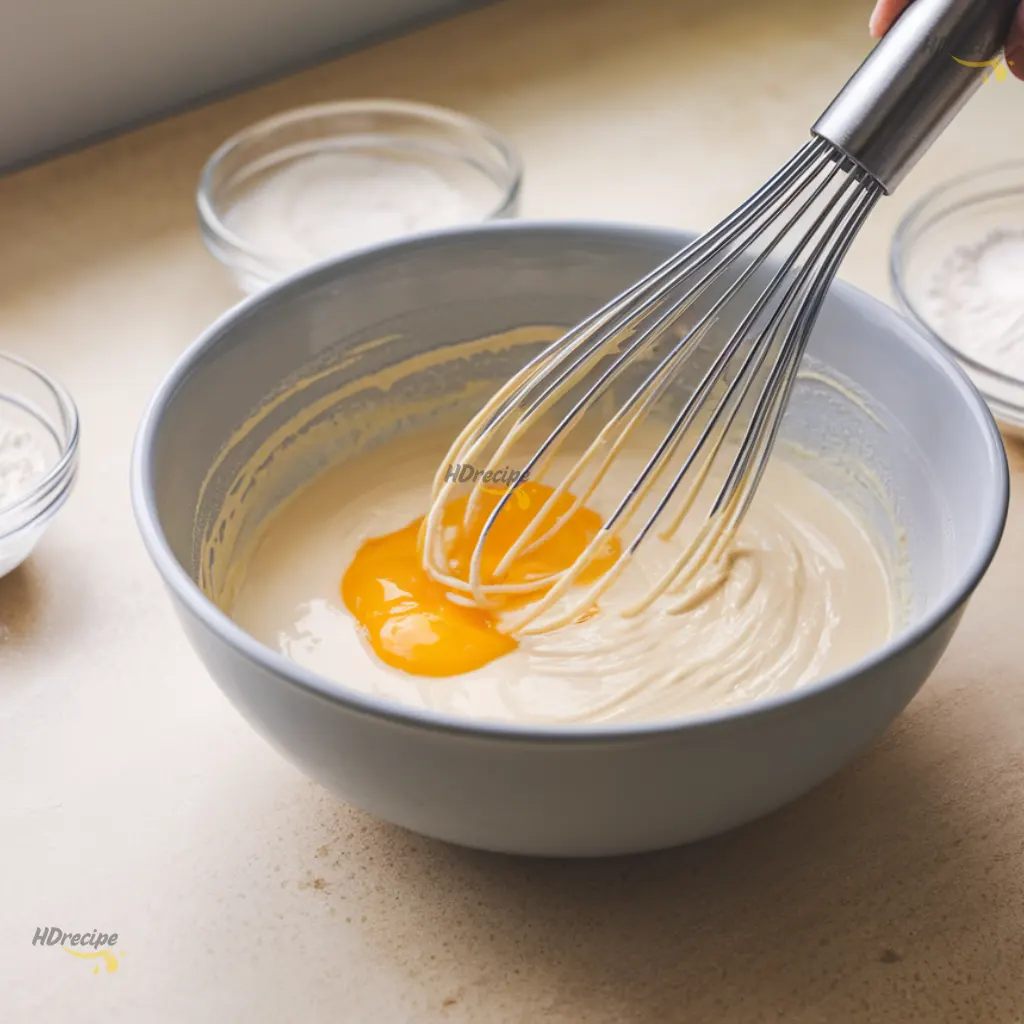
3 Whip the meringue to glossy stiff peaks.
Start beating your egg whites with the cream of tartar on medium speed. After about a minute, when they look foamy and white, start adding the sugar gradually—a little at a time while the mixer runs. Once all the sugar is in, crank the speed up to medium-high and keep going until you get stiff, shiny peaks. This takes about 3–4 minutes total. To test: lift the beaters out. The peaks should stand straight up without drooping. If they fold over, keep beating. The texture should look like marshmallow fluff—smooth, glossy, thick.
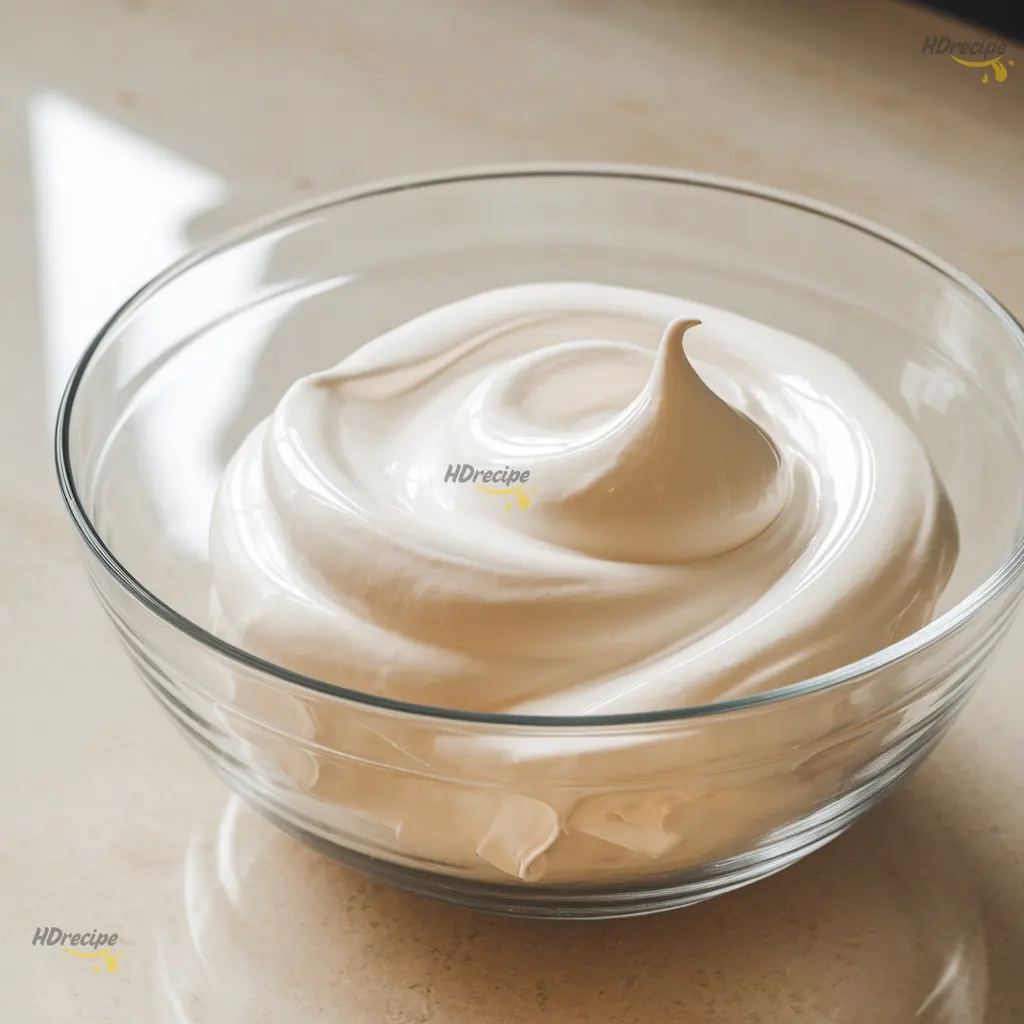
4 Fold everything together without deflating.
This is the step that freaks people out, but it’s easier than it sounds. Scoop about a third of your meringue into the egg yolk mixture. Use a rubber spatula to fold it in with big, gentle swoops—scrape along the bottom, lift up, fold over the top. This lightens the base batter. Now add the rest of the meringue in two more additions, folding the same way. Stop as soon as you don’t see white streaks anymore. Some tiny lumps of meringue are fine—better that than overfolding and losing all your air. The final batter should be thick, fluffy, and hold its shape.
5 Get your pan situation right.
Heat your non-stick pan over the absolute lowest heat setting your stove has. Seriously, lower than you think. Japanese souffle pancakes need to cook slowly so the insides set without the outsides burning. Lightly grease the pan with oil or butter, then wipe most of it away with a paper towel. You want the barest coating—too much grease makes them spread and fry instead of puff.
6 Cook them low and slow.
Scoop large spoonfuls of batter into the pan—you can actually stack them on top of each other to build height since the batter is so thick. Space them a few inches apart. Cook for 4–5 minutes without touching them. You’ll see the edges start to look matte and set, and tiny bubbles will form around the base. Flip carefully using a wide spatula (or two spatulas if you’re nervous). Cook another 4–5 minutes on the second side. If they’re browning too fast, your heat is too high—turn it down or pull the pan off the heat for 30 seconds.
7 Do the doneness check.
When you gently press the top, it should spring back. Give it a very gentle shake—the pancake should wiggle but hold its shape. If it feels liquidy inside or collapses when touched, cover the pan with a lid and give it another minute or two. The goal is cooked through but still tender and jiggly, not dry.
Tiny Details That Make a Big Difference
❃ Your heat matters more than your technique. Even perfect meringue will fail if you cook these over medium heat. The outside will burn before the inside cooks, and they’ll collapse. Low heat feels painfully slow, but it’s the only way to get that even, fluffy texture all the way through. Patience pays off here.
❃ The water trick is legit. Professional Japanese restaurants do this: add a tablespoon of water to the pan after flipping, then immediately cover with a lid for 1–2 minutes. The steam helps cook the thick center without adding more direct heat. Just don’t lift the lid repeatedly or you’ll lose the steam.
❃ Make a tester pancake if you’re nervous. Your first one tells you if your heat is right and gives you a feel for when to flip. It might not be picture-perfect, but you can eat it while the others cook and adjust your technique accordingly.
❃ Use ring molds only if you have them. Greased cookie cutters or egg rings help with uniform shapes, but they’re not necessary. Freeform works fine—they won’t be as Instagram-perfect, but they’ll taste the same. If you do use molds, grease them really well and remove them after flipping.
❃ Whip the meringue right before cooking. Don’t make it ahead. Meringue starts breaking down after about 10 minutes, even if you don’t touch it. Mix your base batter first, then whip the whites and move straight to cooking.
Nutrition (per serving, recipe makes 2 servings)
• Calories: 185
• Carbohydrates: 22g
• Protein: 8g
• Fat: 6g
• Fiber: 0g
• Sugar: 13g
• Sodium: 180mg
❃ Nutrition information is estimated and will vary based on specific ingredients and toppings used.
Stuff People Always Ask About These Pancakes
➲ My pancakes deflated as soon as I flipped them. What happened?
Three likely culprits: your meringue wasn’t beaten to true stiff peaks (keep going longer than you think), you overfolded the batter and knocked out too much air, or your heat was too high and the structure set before the inside could expand. Next time, beat the meringue until it’s really firm and glossy, fold very gently, and double-check that your heat is as low as it goes.
➲ Can I use a different flour?
Cake flour actually works great here and makes them even more tender. Gluten-free all-purpose blends work too—the texture is slightly different but still fluffy. Don’t use whole wheat flour; the extra weight and fiber will make them heavy and dense.
➲ Do these work in advance or as meal prep?
Honestly, not really. The whole point of Japanese souffle pancakes is that light, jiggly texture, which doesn’t survive storage well. You can make them ahead and reheat gently in a low oven (300°F for about 5 minutes), but they lose the magic. These are a “make them fresh” situation—which is part of why they feel special.
➲ I don’t have cream of tartar. Can I skip it?
Yes, but add a tiny squeeze of lemon juice or white vinegar to the egg whites instead (literally 3–4 drops). The acid helps stabilize the meringue. If you don’t have either, just be extra careful with your folding and cook them right away after mixing.
➲ Why do some recipes add more sugar or different ratios?
Japanese souffle pancakes aren’t heavily sweet on their own because they’re meant to be topped with syrup, fruit, or whipped cream. Some recipes up the sugar if you want them sweeter without toppings. The ratio here is pretty standard and tested—more egg whites make them fluffier but harder to manage, less makes them denser.
Final Thoughts Before You Fire Up the Pan Again
Making Japanese souffle pancakes at home is one of those weekend projects that actually delivers on the hype. They take more focus than regular pancakes, sure, but the process isn’t complicated—it’s just precise. And the payoff is worth it: tall, wobbly stacks that taste like clouds and make breakfast feel like an event.
Once you’ve nailed these, you might want to try Out My:
❃ Spaghetti Pancakes Recipe: Why 12M People Can’t Stop Making These
❃ The Best Fluffy Gluten Free Pancakes (Ready in 15 Minutes!)
❃ Easy Scrambled Pancakes Recipe: 15-Minute Healthy Breakfast
❃ Fluffy Mini Pancakes Recipe: 7 Easy Tips for Perfection
Made these? Drop a comment and let everyone know how they turned out. Share your stack photos, your favorite toppings, or the mistakes you made so others can avoid them. And if this guide helped you finally conquer Japanese souffle pancakes, save it in Pinterest for next time and share it with someone who’s been too intimidated to try.
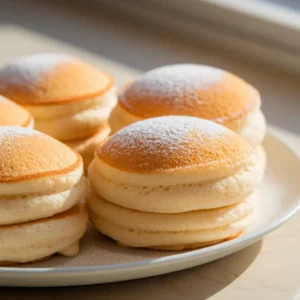
Fluffy Japanese Souffle Pancakes Recipe That Actually Works
Ingredients
- 2 large eggs separated (room temperature)
- 3 tablespoons whole milk
- 1/2 teaspoon vanilla extract
- 1/4 cup all-purpose flour
- 1/2 teaspoon baking powder
- 2 tablespoons granulated sugar
- Pinch of salt
- 1/4 teaspoon cream of tartar optional
- Butter or oil for cooking
- Powdered sugar for dusting
- Maple syrup for serving
- Fresh berries optional
Instructions
- Separate eggs into two clean bowls. Whisk egg yolks with milk and vanilla. Sift in flour, baking powder, and salt. Mix until just combined and set aside.
- Beat egg whites with cream of tartar on medium speed until foamy. Gradually add sugar while beating. Increase speed to medium-high and beat until stiff, glossy peaks form, about 3-4 minutes total.
- Fold one-third of meringue into yolk mixture gently. Add remaining meringue in two additions, folding with a rubber spatula until no white streaks remain. Batter should be thick and fluffy.
- Heat non-stick pan over lowest heat. Lightly grease and wipe excess. Spoon batter into tall mounds. Cook 4-5 minutes per side until golden and springy. Cover with lid if needed for thicker centers.
Notes
- Use 2% milk instead of whole milk
- Substitute cake flour for even fluffier texture
- Use gluten-free all-purpose flour for gluten-free version
- Replace cream of tartar with 3-4 drops lemon juice or white vinegar
